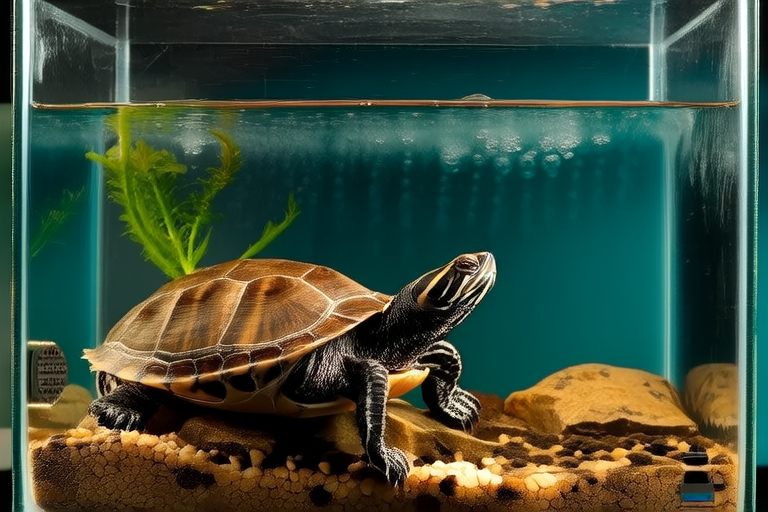How to Create the Perfect Habitat for Your Red-Eared Slider Turtle
Welcome to the wonderful world of red-eared slider turtles! These fascinating reptiles require a specific habitat that mimics their natural environment to thrive. In this comprehensive guide, we’ll cover everything you need to know about setting up the perfect habitat for your red-eared slider turtle, from the essential equipment to maintaining water quality and providing a balanced diet.
The Importance of Mimicking Natural Environments
Red-eared slider turtles are semi-aquatic, meaning they spend part of their time in water and part on land. Their natural habitats consist of calm waters such as ponds, lakes, and slow-moving rivers surrounded by basking areas. Creating an environment that closely resembles these conditions is crucial for your turtle’s health and longevity. A well-maintained habitat will help prevent illnesses and promote a long, happy life for your pet.
Necessary Equipment: Tanks and Lighting
Choosing the right tank is essential for your turtle’s well-being. A minimum of 20 gallons per inch of shell length is recommended for one adult turtle. For instance, a 40-gallon tank would be suitable for a fully grown red-eared slider with a 4-inch shell. Ensure the tank has a secure lid or cover to prevent escapes and keep curious pets or children away from the turtle.
Proper lighting is also critical. Turtles require UVB light to synthesize vitamin D3, which helps them absorb calcium for strong shells and bones. Invest in a high-quality UVB bulb specifically designed for reptiles, and place it within 12 inches of where your turtle will bask. Remember to replace the bulb every six months, even if it still appears to be working, as UVB output diminishes over time. Additionally, provide a heat lamp to maintain the desired basking area temperature between 85°F and 90°F (29°C to 32°C).
Water Quality Maintenance
Maintaining clean water is vital for your turtle’s health. Use a filter that can handle at least five times the volume of water in your tank per hour to keep the water clear and free of harmful bacteria. Perform weekly water changes, replacing approximately 25% of the water each time. During these changes, gently scrub the sides and bottom of the tank to remove algae and debris. Consider using a dechlorinator to neutralize chlorine and chloramines found in tap water, which can be harmful to your turtle.
Temperature Regulation
Red-eared sliders are ectothermic, meaning they rely on external sources of heat to regulate their body temperature. Besides the basking area mentioned earlier, the water temperature should remain between 75°F and 80°F (24°C to 27°C). You can achieve this by using submersible heaters placed in the tank. Always monitor the water temperature with a reliable thermometer to ensure it stays within the optimal range.
Diet Specifics
Feeding your red-eared slider a balanced diet is key to its overall health. Juvenile turtles should eat primarily commercial turtle pellets supplemented with fresh vegetables like romaine lettuce, collard greens, and dandelion greens. As they mature, their diet should shift towards a more plant-based regimen, with occasional protein sources like earthworms, crickets, or small pieces of fish. Avoid feeding your turtle iceberg lettuce, as it lacks nutritional value and can cause digestive issues. Feed your turtle only what it can consume in 15 minutes, and remove any uneaten food to prevent water contamination.
Safety Measures
Ensure the safety of your turtle by avoiding sharp or abrasive decorations that could injure it. Opt for smooth rocks, driftwood, or commercially available aquarium decor. Provide a shallow ramp or floating dock to allow easy access between the water and land areas. Keep your turtle’s habitat away from drafts and direct sunlight, which can cause temperature fluctuations detrimental to its health.
Tips for Beginners
Starting with a smaller tank and gradually increasing its size as your turtle grows can help manage costs and space requirements. Regularly observe your turtle’s behavior and appearance for signs of illness, such as lethargy, loss of appetite, or swollen eyes. Joining local turtle forums or online communities can provide valuable support and advice from experienced turtle owners.
Common Mistakes to Avoid
Avoid overcrowding your tank, as it can lead to stress and increased risk of disease. Do not overfeed your turtle, as excess food can degrade water quality and cause health problems. Refrain from handling your turtle excessively, as frequent human contact can disrupt its natural behaviors and stress levels.
Conclusion
Creating the perfect habitat for your red-eared slider turtle requires attention to detail and commitment to maintaining optimal living conditions. By investing in the right equipment, monitoring water quality, regulating temperature, providing a balanced diet, and taking safety precautions, you can ensure your turtle leads a healthy and fulfilling life. Remember, the closer you can mimic their natural environment, the happier and healthier your turtle will be. Happy turtle keeping!
